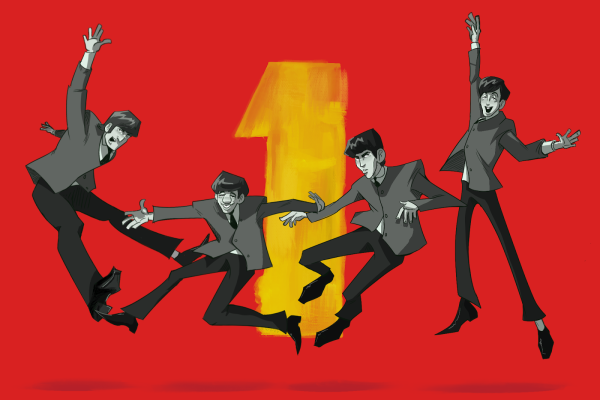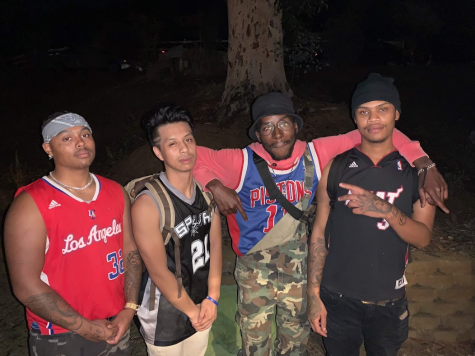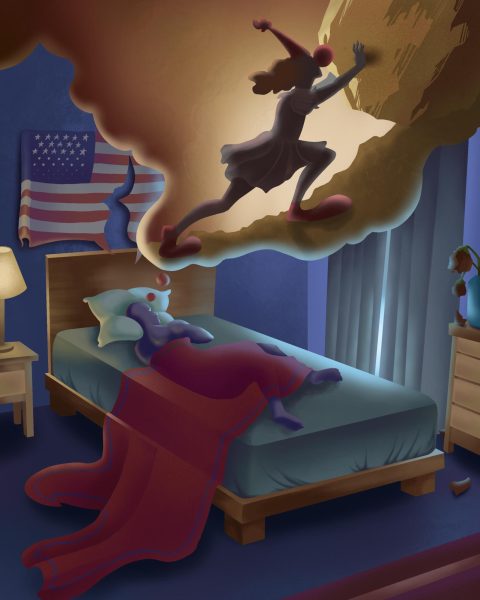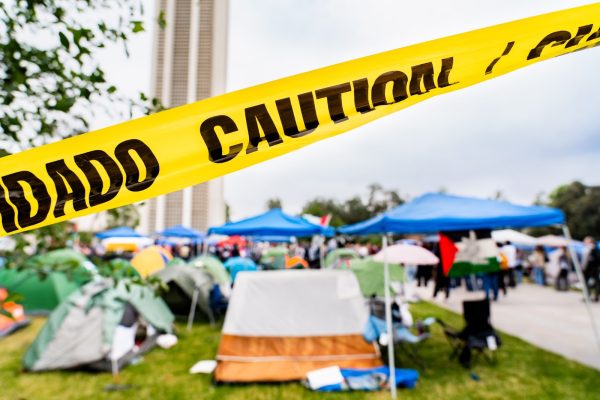Hazing death forces frat boys and sorority girls to put the paddle down
Traditional Greek life hazing banned at colleges around the country
Story by Angelica Loera and Jennifer Sandy
Friday night, nine o’clock sharp, and the next three to four hours will consist of fearful anticipation. Only 3,379 push-ups, 2,001 crunches, and seven parched nightfalls until his transition to kinship.
Thump … thump.…
His heart continued to race behind the time bomb of dehydration through the blackened hike in a vaguely recognizable forest.
Thump … thump….
Vigorous calisthenics in the dirt brought him closer to the completion of what would make him an eligible man, and the isolation from civilization in the mountains would prove the strength of a lone wolf. It did not matter if it hurt, or if the demeaning nature of it all challenged or altered his self-esteem. In nine weeks he would be a cavalier of sorts.
It was all worth it, right?
Thump … thump.
This summer at California State University Northridge, Pi Kappa Phi pledge Armando Villa, 19, was found dead in the Los Angeles National Forest after a barefoot hike with scarcely enough rationed water. Within two days of his death, the national fraternity suspended the chapter and the university elected to withdraw Pi Kappa Phi from its institution. In 2009, the same fraternity at California Polytechnic University Pomona was suspended for an alleged hazing after a student was severely burned in the process of blindfolded branding.

Since September of 2006, Matt’s Law, also known as the California Hazing Law, protects fraternity and sorority hopefuls from painstaking initiation rituals by allowing felony charges to be brought against physically and mentally harmful hazing procedures. Yet the law fails to address the psychologically demanding loopholes that burrow into Greek life’s aspirants. Somewhere along the winding journey that is meant to guarantee a spot in the Panhellenic pedigree, a sense of allegiance and competence still silences the contenders. So who’s to prove any mental abuse? It seems like consent is in the eye of the beholder and legal consequences can only go so far.
In Villa’s case, it is likely safe to deduce that the three men faced a mentally and physically demanding decision of whether or not to proceed with the challenge. A summary of the 61-page report accounts that Villa and other pledges were forced to give up their keys, phones and shoes and then taken to the Angeles National Forest. The three pledges, including Villa, had a gallon of water each plus a case of 12-ounce bottled waters to split among them and their leaders. The report states: “Coming down the hill it appears that many on the hike were becoming disoriented, dehydrated and may have been suffering from heat exhaustion.” The Los Angeles County Coroner’s office ruled that Villa’s death was a combination of dehydration and hypothermia. The coroner’s report coincided with CSUN’s investigation that the group ran out of water while hiking down the mountain.
But what led these men to take on this challenge in the first place, despite knowing of alleged blood already on Pi Kappa Phi’s hands?
California State University Northridge student Ben Wrighton*, a 22-year-old engineering major, withdrew from an initiation process his first year at the university. “I can see why some felt like it was helping them build character or making them stronger,” Wrighton said. “People don’t speak up because they want to belong. Some people don’t have a very strong sense of self worth, and some of these organizations take that and present themselves as a sort of paradise where you suddenly have tons of friends, access to alcohol and sex, and they feel that it’s enough to jump through hoops. Some people are easily manipulated.”
In February, six members of Alpha Phi Alpha fraternity at the University of Akron were accused of paddling a pledge over the course of several weeks to the point where the student’s buttocks became infected and required a two-day admission to a hospital for treatment. According the the police report, the victim, a 21-year-old Lorain County resident, was among five pledges who were undergoing initiation. Cleveland.com reported that over the course of three weeks, the men were taken to several off-campus locations for sets or hazing parties. At those locations the pledges underwent what the victim called “wood” strikes.
Luckily, there are still organizations that persuade students by their academic support and friendliness. Charles Aramayo, a 21-year-old pre-med and political science major at UCLA, can vouch for Greek life’s silver lining.
“Kappa Sigma has a VERY strict no hazing policy,” Aramayo said. “We don’t believe hazing is conducive to building brotherhood and strong relationships. Things like studying, eating, and learning fraternity history together brings [these guys] closer together. While we have our share of night life, academics is a high priority as well as volunteer and service hours and that seemed like a group of guys I wanted to surround myself with.”
Loyola Marymount University alumnus Ana Perez, 22, was a screenwriting major involved in Greek life that encouraged learning history, having meetings, grueling study hours, and attending events.
“The paddle idea traditionally stems from paddling recruits as a punishment and having them carry it around as an overall inconvenience, because it can be heavy,” Perez said. “Many organizations humiliate or belittle you at meetings to test your commitment to them. Some are stricter, and treat their pledge class as useful resources for being designated drivers and errand girls so the pledges are at the whim of the members. This is easily abused in many cases.”
In a world where coexisting with a bunch of young adults is a potentially beneficial option, psychologist Leon Festinger’s cognitive dissonance theory is involved, but psychologist Daniel Kahneman’s prospect theory prevails. According to SimplyPsychology.org, cognitive dissonance is the psychological conflict that occurs when one has incongruous beliefs and attitudes held simultaneously. This would explain someone’s discomfort and mental stress while rushing a sorority or fraternity and still somehow finding the motivation to do it anyway. Kahneman’s theory addresses a concept known as risk-aversion. Risk-aversion demonstrates that a person is more willing to accept a reward that is guaranteed, rather than take a risk and possibly get an even greater reward. This explains why fraternity rushers participate in the humiliation of hazing—if they put up with the pain now, they’ll be accepted by the fraternity and instantly have an association of friends. If they don’t, the hazing will stop, but they may face social isolation for the next four years.

And hazing isn’t just happening on college campuses. Several Sayreville War Memorial High School football players appeared in court this week over allegations of sexual assault and hazing against seven football team students that included aggravated sexual assault, aggravated criminal sexual contact, conspiracy to commit aggravated criminal sexual contact, criminal restraint, and hazing for engaging in an act of sexual penetration upon one of the juvenile victims. According to NJ.com, five others were charged with various counts including aggravated assault, conspiracy, aggravated criminal sexual contact, hazing and riot by participating in the attack of some of the victims. Mel Robbins, CNN commentator and legal analyst and founder of Inspire52.com, a news and entertainment site for women, wrote the article “Stop Saying You’re Fine, what happened at Sayerville wasn’t hazing, it was rape.” Robbins reported, “In the darkness, a freshman football player would be pinned to the locker-room floor, his arms and feet held down by multiple upperclassmen. Then, the victim would be lifted to his feet” and sexually abused. And this wasn’t the first time; it was a tradition of sorts. So when do these rituals become sick, twisted and dangerous? Even more important is why these students will subject themselves to such humiliation.
CSUN student Wrighton said that paying for a social life is somewhat “pathetic.”
“I feel like paying for a social life is already kind of sad, but letting a group of guys your age treat you like a piece of trash in the name of brotherhood is downright pathetic. One wouldn’t make their blood brother go through extreme physical exercises and verbal abuse, and with the dues you’re required to pay, this extra stuff is out of place.”
Since college is a blank slate for some, it is no surprise the lengths students are willing to take to feel a sense of belonging and common ground. And while students claim to have questioned their self-concept, any psychological abuse charges would be still be unclear. Did they not choose to endure such psychological distortion in the name of brotherhood?
Psychologist Stanley Milgram analyzed the act of obedience in his famous 1961 study of obedience to authority figures, which began shortly after the trial of Adolf Eichmann, one of the major perpetrators of the Holocaust. The trial questioned the mindset and intentions of his accomplices. In Milgrim’s study concerning levels of morality, people are simply compelled to obey orders because of the way they are brought up. Milgram reported his findings in 1963 in an article titled “The Behavioral Study of Obedience” in the Journal of Abnormal and Social Psychology. So hazing tendencies seemingly trace back to historical tragedies, and Milgram’s results are analogous to hazers in today’s educational realm.
“I think they enjoy being the one with power after having none as a pledge. I was like that too,” Perez said. “I could push them the same way I was pushed now that I had earned my letters just because I could. ”
Some schools, like Loyola Marymount University in Los Angeles, have strict regulations regarding initiation and severe consequences for hazing. All Greek organizations follow a uniform procedure and anything else outside of these boundaries could mean chapter withdrawal and expulsion. While the partying and social perks are still prevalent, it is regulations like these that still enforce an investment into a chapter’s philanthropic purpose.
“It’s all a test and some go harder solely to break you down emotionally,” Perez said. “The fact that everyone from the beginning did the same process, makes it part of tradition and culture. It would lessen the legitimacy of future members who don’t do what everyone else did before them. For [extremists], if a pledge defends herself or walks away that could mean [pride and self worth] but could also mean disobedience or disrespect. Either way, as a pledge you can’t win. You have to listen to your educators-the ones who guide you in the process of being a member at the meetings.”
So after examining each side of the conflict, perhaps we can more carefully regard our initial investigation:
Is it all worth it?
Perez concluded, “It broke me down emotionally because of the stress, but I gained more than I lost at the same time. My sisters all felt the pain and we had to keep our spirits up. So I believe in a process that is beneficial for everyone. Mine was tough but I grew more confident in myself.”
Maybe it is simply human nature’s power-hungry qualities that dim the light of Greek life’s charitable intentions. The consequences of hazing have been brought to light in the media and may result in preventing tragedies for those contemplating this potentially dark journey.
*Name changed to protect source’s privacy.
Substance is a publication of the Mt. San Antonio College Journalism Program. The program recently moved its newsroom over to Medium as part of a one-year experiment. Read about it here.











